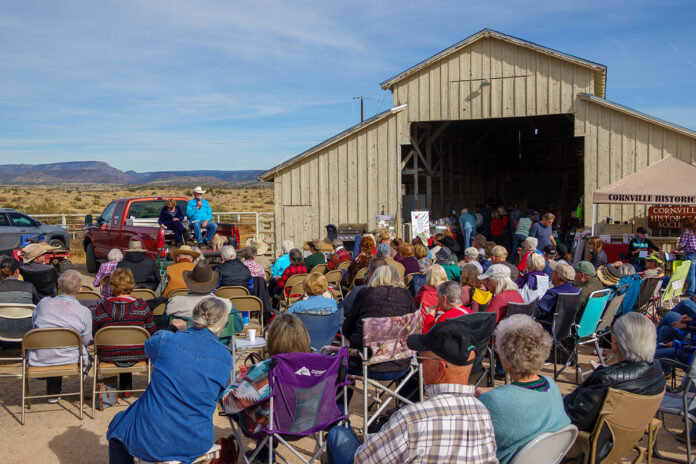The Cornville Historical Society hosted its annual holiday fundraiser at the Apache Maid Ranch on Sunday, Dec. 3. The event featured a talk by Don Godard, a former ranch worker and Cornville resident knowledgeable about the ranch’s history.
Godard gave his talk, “Ranching on the Apache Maid,” from the back of a pickup truck with his wife and dog at his side. The talk was held at the lower ranch headquarters, which dates back to the 1940s.
The Apache Maid Ranch was established in the 1880s and has since become one of the largest ranch operations in northern Arizona, stretching over fifty miles eastward from Cornville to its upper ranch headquarters on Apache Maid Mountain.
Janet Cassagio of the Cornville Historical Society has documented multiple primary sources that confirm that some form of interaction between an American Indian woman and settlers was the source of the mountain’s or ranch’s name.
Some accounts state that soldiers found an abandoned Indian girl and took her to Fort Verde. Another says troops killed an Apache woman and her baby was taken to the fort, while another claims that a lost Apache girl saw smoke from settlers and sought refuge with them.
A different story from Bill Cowan involves a party of soldiers shooting into a moving blanket before finding three children under it, one of whom was killed while the other two, who were brother and sister, survived. The sister was adopted by locals and later became the Apache maiden for which the mountain was named.
The ranch was initially homesteaded by the Marr brothers prior to 1884. Seth “Boss” Acker purchased the ranch in 1884 to supply meat to his butcher business in Flagstaff. The ranch has changed hands many times since then.
Godard said that the ranch is divided into 15 parcels that support 400 cows, 55 bulls and 10 horses. They move the cattle every two to four weeks. The ranch also contains between 300 and 400 miles of fencing and 50 and 75 miles of water pipelines that have to be maintained. Godard joked that the foreman isn’t just a cowboy, he’s a plumber, too.
When the cows calve in January is when the work really starts, Godard added. He said that being a cowboy is a 24-hour job with no down time.
“If you really want to be a cowboy, think about it,” Godard jokingly advised his audience.
He invited family members, past cowboys and ranch hands and anyone who had previously lived on the ranch to share their stories.
A pair of cousins whose grandparents used to own the ranch in the 1980s shared their memories of spending their summers here riding horses, when the ranch was their playground. One woman said that if you dropped the reins, the horses always knew how to get back home.
Godard said that on the ranch, kids don’t learn to walk, they learn to ride, often at age three or four.
“That’s why when we get older, we don’t like to walk,” Godard said. “I haven’t seen a cowboy yet that likes to walk.”



